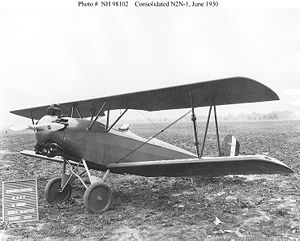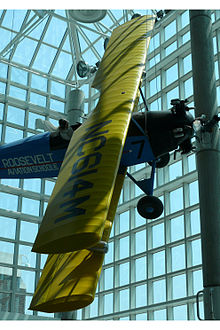- Fleet Model 1
-
Model 1 US Navy N2Y-1 Role Recreational and training aircraft Manufacturer Consolidated, Fleet Designer Reuben Fleet First flight 9 November 1928 The Fleet Model 1 (originally the Consolidated Model 14 Husky Junior) and its derivatives were a family of two-seat trainer and sports plane produced in the United States and Canada in the 1920s and 30s. They all shared the same basic design and varied mainly in their powerplants. They were all orthodox biplanes with staggered, single-bay wings of equal span and fixed tailskid undercarriage. Accommodation was provided for two in tandem, originally sharing a single open cockpit, but in most examples in separate open cockpits. The fuselage was made of welded steel tube with Warren truss construction pattern side structures typical of the time, and the wings had a wooden spar with duralumin ribs, the entire aircraft being fabric-covered. Despite a superficial resemblance to Consolidated's highly successful Trusty and Husky designs (hence the "Husky Junior" nickname), the Model 14 was an all-new design.
Originally created as a means for Consolidated to enter the civil market, the company abandoned this ambition shortly before the completion of the first prototype. The manufacturing rights were purchased by designer and Consolidated company president Reuben Fleet to put into production himself under a new enterprise, Fleet Aircraft. It was an immediate success, and in the first year of production alone, over 300 machines were sold. Consolidated quickly responded by buying Fleet Aircraft and retaining it as a subsidiary while opening a second production line at Fort Erie, Ontario, Canada. Canadian manufacturing was a great success, with some 600 examples built for the Royal Canadian Air Force as the Fleet Fawn (Model 7) and Fleet Finch (Model 16).
A small number of US-built machines were purchased by the US military, including a batch evaluated by the United States Army Air Corps as the PT-16 but not bought in quantity, and six specialised N2Y trainers for the United States Navy equipped with hooks to catch the trapeze on aircraft-carrying airships and train F9C Sparrowhawk pilots.
US manufacturing rights were eventually sold to Brewster, which intended to produce the Brewster B-1 based on the Canadian Model 16F.
Variants
- Consolidated Model 14 Husky Junior - prototypes (ca. 5 built)
- Fleet Model 1 - initial production version with Warner Scarab engine (ca. 90 built)
- Fleet Model 2 - initial production version with Kinner K-5 engine (203 built)
- PT-6 - USAAC designation for Model 2 (16 built)
- N2Y-1 - USN version with trapeze hook for airship docking training (5 built)
- Fleet Model 3 - version with Wright J-6 engine (1 converted from Model 2)
- Fleet Model 4 - version with Curtiss Challenger engine (1 built)
- Fleet Model 5 - version with Brownback C-400 engine (1 built)
- Fleet Model 6 - improved version for USN as XN2Y-2, later further modified as an autogiro by Pennsylvania Aircraft with the upper wing replaced by a rotor, it was redesignated XOZ-1 (1 built)
- Fleet Model 7 - version with Kinner B-5 engine (48 built, plus several converted from Model 2 by Fleet in Canada)
- Fleet Model 7A
- Fleet Model 7B - Canadian production version
- Fleet Model 7C - Canadian production version with Armstrong Siddeley Civet engine
- Fleet Model 7G - Canadian production version with de Havilland Gipsy III engine
- XPT-6 - One Model 7 acquired by the US Army Air Corps for service tests. Version with 100-hp Kinner R-370-1 (Kinner K5) engine
- YPT-6 - ten aircraft similar to the XPT-6, used by the US Army Air Corps for service tests and evaluation
- YPT-6A - modified version of the Model 7 fitted with an enlarged cockpit. Used by the US Army Air Corps for service tests and evaluation
- Fleet Model 8 - three-seat version similar to Model 7 (7 built)
- Fleet Model 9 - refined version of Model 8 (12 built)
- Fleet Model 10 - refined version of Model 7 for export to Europe
- Fleet Model 10A - version with 100 hp Kinner engine
- Fleet Model 10B - version with 125 hp Kinner engine
- Fleet Model 10D - version with 160 hp Kinner engine
- Fleet Model 10-32D - generally similar to the Model 10D, but with an increased 4-ft 0-in (1.22-m) wingspan
- Fleet Model 10E - version with 125 hp Warner engine
- Fleet Model 10F - version with 145 hp Warnerengine
- Fleet Model 10G - version with de Havilland Gypsy Major engine for governments of Portugal and Romania (ca. 70 built)
- Fleet Model 10H - version with Menasco C-4S engine
- Fleet Model 11 - version with Kinner R-5 engine; some exported to China and Mexico
- Fleet Model 14 - Model 2 modified for participation in Guggenheim Safe Aircraft Competition but disqualified. ca. 300 licence-built in Romania.
- Fleet Model 16 - Fleet Finch - strengthened Canadian production version with sliding canopy, powered by a 130 hp de Havilland Gipsy Major engine (ca. 600 built)
- Fleet Model 16B - Fleet Finch Mk II - Strengthened Canadian production version, powered by a Kinner B5 engine
- Fleet Model 16D - similar to the Model 16B, but fitted with a Kinner B5 engine
- Fleet Model 16F - prototype for Brewster B-1
- Fleet Model 16R - Fleet Finch Mk I - designation of the Fleet 16D built in Canada for the RCAF
- Fleet Model 21 - armed version built in Canada for Mexican Air Force (11 built)
- Fleet Model 21M - designation for a one-off demonstration aircraft
- Fleet Model 21K - redesignation of the Model 21M, after it was subsequently sold to a private buyer
Operators
Specifications (Model 2)
General characteristics
- Crew: One pilot
- Capacity: 1 passenger
- Length: 21 ft 8 in (6.61 m)
- Wingspan: 28 ft 0 in (8.54 m)
- Height: 7 ft 9 in (2.36 m)
- Wing area: 194 ft2 (18.0 m2)
- Powerplant: 1 × Kinner K-5, 100 hp (75 kW)
Performance
- Maximum speed: 105 mph (169 km/h)
- Range: 350 miles (560 km)
- Service ceiling: 12,200 ft (3,700 m)
References
- Taylor, Michael J. H. (1989). Jane's Encyclopedia of Aviation. London: Studio Editions. pp. 263. ISBN 0710607105.
- World Aircraft Information Files. London: Bright Star Publishing. File 894 Sheets 24–25. ISBN 1156943825.
- Aerofiles.com
- Howard, Frederic (June 1967). "The History Of The 1930 Fleet". American Aviation Historical Society Journal.
- Shattuck, Lemuel C. (December–January 2008). "Restoration: Fleet Model 8". Air & Space.
See also
USAAC/USAAF/USAF/Tri-service trainer aircraft Advanced Trainer Basic Combat Basic Trainer Primary Trainer (1924-1948) Trainer (1948-1990) "T-1", "T-2", "T-3" and "T-6" have also been assigned since 1962 in a separate sequence.USN/USMC trainer aircraft designations 1922-1948 Boeing NB • N2B
Curtiss (NC not assigned) • N2C
Piper Huff-Daland Howard North American Keystone Langley Martin (NM not assigned) • N2M
Naval Aircraft Factory Spartan NP
Fairchild Ryan Stearman New Standard Timm Consolidated USN observation aircraft designations, pre-1962 Observation OB • O2B
EliasHuff-DalandOKMO • M2O
VikingPitcairnPennsylvania AircraftXOZObservation Scout EdoXOSN • OS2N
StearmanAircraft designed/manufactured by Fleet Aircraft Fleet 1 · Fleet 2 · Fleet 5 · Fleet 7 Fawn · Fleet 10 - 16 Finch · Fleet 21 · Fleet 50 Freighter · Fleet 60 Fort · Fleet 80 Canuck · Fleet helicopter
Aircraft produced by Consolidated Aircraft Manufacturer designation By role Lists relating to aviation General Aircraft (manufacturers) · Aircraft engines (manufacturers) · Airlines (defunct) · Airports · Civil authorities · Museums · Registration prefixes · Rotorcraft (manufacturers) · TimelineMilitary Accidents/incidents Records Categories:- United States sport aircraft 1920–1929
- United States civil trainer aircraft 1920–1929
- Consolidated aircraft
- Single-engine aircraft
Wikimedia Foundation. 2010.



